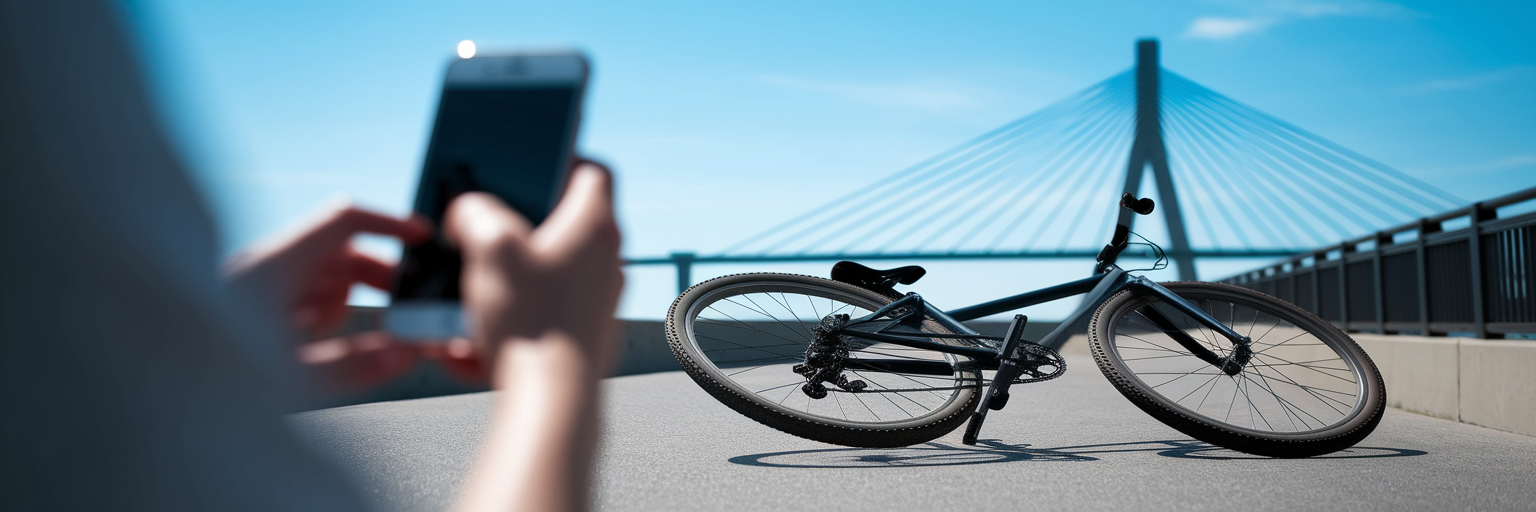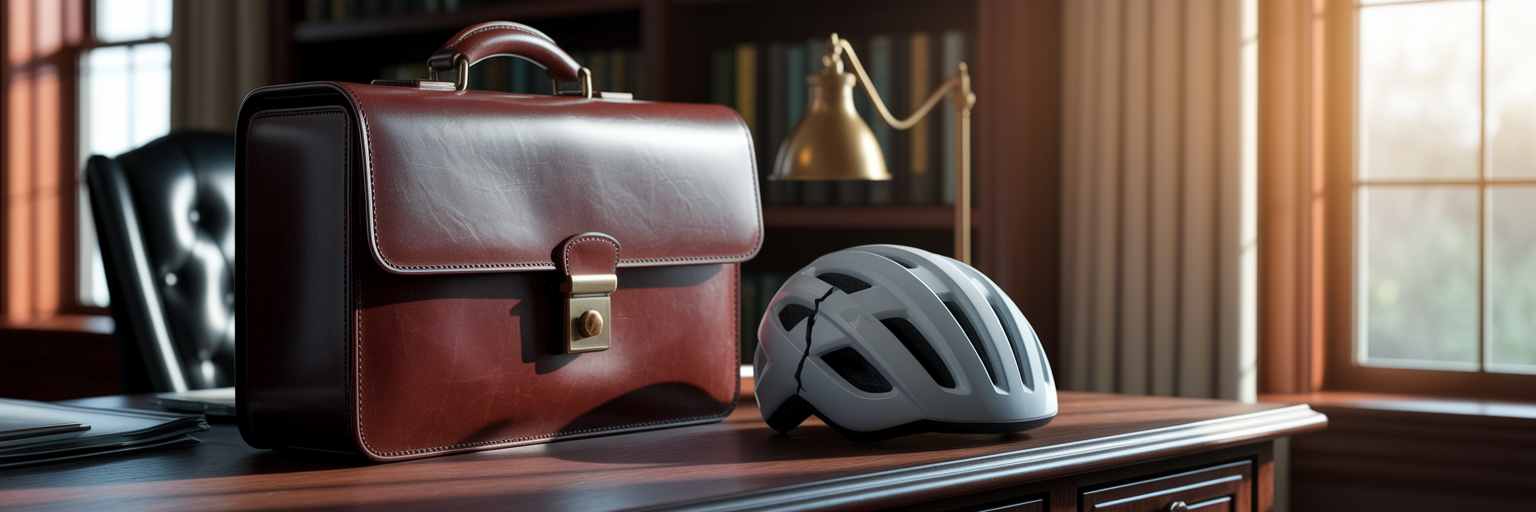The view from the Arthur Ravenel Jr. Bridge is one of Charleston’s most iconic experiences, offering a stunning panorama of the harbor. But in an instant, that scenic ride can be shattered by the jarring reality of a bicycle crash. The moments that follow are often filled with confusion, shock, and pain. Knowing what to do after a bike accident is not just about procedure; it’s about protecting your health and your rights from the very start.
Immediate Steps to Take at the Accident Scene
In the immediate aftermath of a crash, your first priority is safety. Adrenaline can easily mask the severity of an injury, making you feel fine when you are not. Your actions in these first few minutes are critical.
Follow these steps methodically:
- Move to a Safe Location: If you are able, move yourself and your bicycle out of the path of traffic. The bridge’s bike lane is narrow, and remaining in a high-traffic area puts you at risk of another collision. If you are seriously injured, do not move and wait for help.
- Call 911 Immediately: Report the accident to the police and request paramedics, even if you believe your injuries are minor. A police report creates an official record of the incident, and a medical evaluation is non-negotiable. Some injuries, like concussions or internal bleeding, are not immediately apparent.
- Wait for First Responders: Do not leave the scene before the police and emergency medical technicians arrive. Provide the responding officer with a factual account of what happened. Accept medical attention at the scene and follow their recommendations for a hospital visit.
Remember, the shock of an accident can cloud your judgment. Letting professionals assess your health is the single most important step you can take for your well-being.
Gathering Critical Evidence on the Bridge
Once you have addressed your immediate safety and called for help, the next step is to document the scene, but only if you are physically able to do so. The evidence from a Ravenel Bridge bike accident can disappear quickly as traffic resumes and vehicles leave. Creating your own record ensures that crucial details are preserved.
When interacting with the driver involved, remain calm and stick to the facts. Avoid apologies or any statements that could be interpreted as admitting fault. We all have that instinct to say “I’m sorry” even when we did nothing wrong, but in this context, those words can be used against you. Instead, focus on exchanging contact and insurance information.
Use your phone to capture as much information as possible. A detailed photographic record can be invaluable later. While you are waiting for police, try to document everything you see. This evidence can be complex to sort through, but a Charleston personal injury lawyer from our firm can help you understand how each piece fits together.
| Evidence Type | What to Capture | Why It’s Important |
|---|---|---|
| Scene Photos | Wide shots of the area, traffic flow, weather | Establishes context and conditions. |
| Vehicle Damage | Photos of your bike, helmet, and the other vehicle | Documents the points of impact and severity. |
| License Plate | A clear photo of the other vehicle’s license plate | Ensures you can identify the driver and vehicle. |
| Your Injuries | Close-ups of any cuts, bruises, or scrapes | Creates a visual record of physical harm. |
| Road Hazards | Potholes, debris, or unclear lane markings | Can indicate if poor maintenance was a factor. |
| Witness Information | Names, phone numbers, and email addresses | Provides third-party accounts of the event. |
Note: This checklist should only be followed if you are physically able to do so without risking further injury. Your personal safety is the top priority.
The Importance of Official Reports and Medical Follow-Up
The actions you take in the hours and days after the crash are just as important as what you do at the scene. This is the time to build the official foundation for your recovery, both physically and financially. The police report serves as the primary official narrative of your bicycle accident in Charleston, SC. You should obtain a copy as soon as it becomes available from the relevant police department, whether it’s the Charleston Police Department or Mount Pleasant Police Department, depending on the location of the crash.
Beyond any emergency room visit, schedule a follow-up appointment with your primary care physician. Explain what happened and describe any pain or discomfort, no matter how minor it seems. Soft tissue injuries and concussions can have delayed symptoms. As noted in a guide from Enjuris on bicycle accident liability, keeping detailed records of all medical treatments and related expenses is essential to support an injury claim. This creates a documented link between the accident and your injuries.
Start a dedicated folder to keep track of all accident-related expenses. This documentation is critical for demonstrating the financial impact of the crash. Be sure to save:
- Medical Bills: Including hospital visits, doctor’s appointments, physical therapy, and prescriptions.
- Repair or Replacement Costs: Get a written estimate for repairing or replacing your bicycle and any other damaged property like your helmet or phone.
- Records of Lost Wages: Keep track of any time you missed from work, including paid time off you had to use.
Because many bicycle accidents involve motor vehicles, the principles of evidence collection often align with those in car crashes. The insights shared by our experienced Charleston car accident lawyers can provide additional context for building your case.
Understanding Liability Under South Carolina Law
After a crash, one of the biggest questions is, “Who was at fault?” In South Carolina, the answer to this question determines your ability to recover compensation. The legal framework is built on the concept of negligence and a specific rule about shared fault.
Defining Negligence in a Bicycle Accident
Negligence is not about a person’s intent; it is about their failure to act with reasonable care. For a driver to be found negligent, you must show they breached their duty to share the road safely. This could mean they were texting while driving, failed to yield, or followed too closely. Proving this breach of duty is central to any personal injury claim.
South Carolina’s Comparative Fault Rule
Many people assume that if they are even slightly at fault for an accident, they cannot recover any damages. This is not true in South Carolina. The state follows a “modified comparative fault” rule. According to the Law Offices of James Scott Farrin, this rule means you can recover damages as long as you are not more than 50% at fault for the accident. If you are found to be, for example, 20% at fault, your total compensation would be reduced by 20%. This aspect of South Carolina bike laws is crucial for cyclists to understand.
Potential Liable Parties
While the other driver is the most obvious at-fault party, they may not be the only one. Liability can be more complex. For instance, if a dangerous road condition like a large, unmarked pothole on the bridge contributed to the crash, a government entity could share responsibility. An experienced attorney can investigate all potential sources of liability.
Filing a Claim and Protecting Your Legal Rights
Once you have gathered evidence and sought medical care, the next step is to pursue fair compensation for your injuries and losses. This is where navigating the insurance and legal systems begins, and it is a process you should not face alone. Insurance adjusters are trained to minimize payouts, and their goals are not aligned with yours.
This is the point where a dedicated Charleston personal injury lawyer becomes your most important advocate. An attorney will handle all communications with the insurance companies, protect you from pressure to give a recorded statement, and build a claim that accurately reflects your damages. This includes not only your medical bills and lost wages but also your pain and suffering.
It is important to act promptly. In South Carolina, the statute of limitations for filing a bike accident claim SC is generally three years from the date of the accident. While that may seem like a long time, evidence can be lost and memories can fade. Starting the process sooner ensures that your case is built on the strongest possible foundation.
A bicycle crash on the Ravenel Bridge can disrupt your life in countless ways. Protecting your rights starts with taking the right steps from the beginning. To understand your options and ensure you are treated fairly, do not hesitate to reach out for a consultation. You can contact us today to discuss your case with our team.


